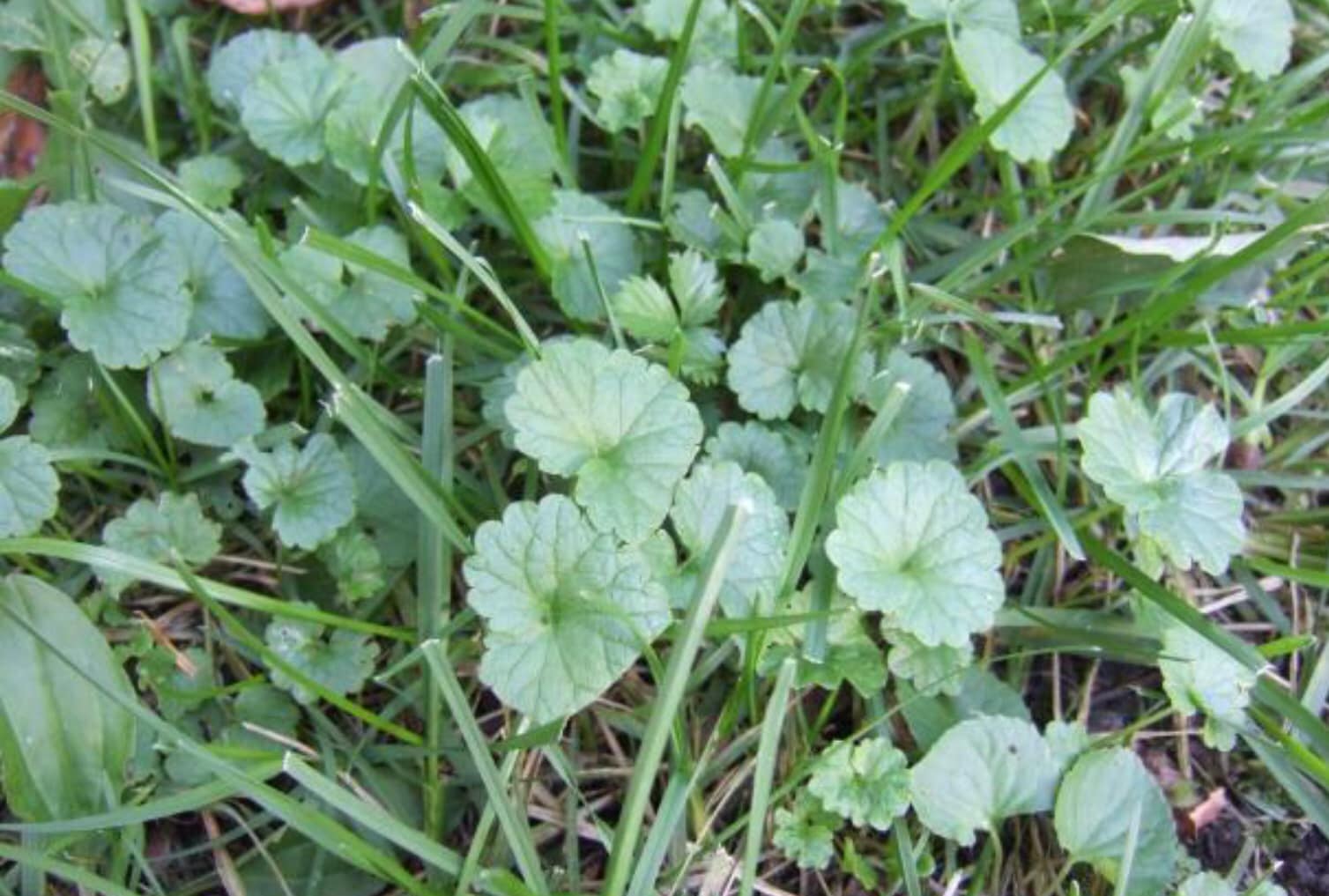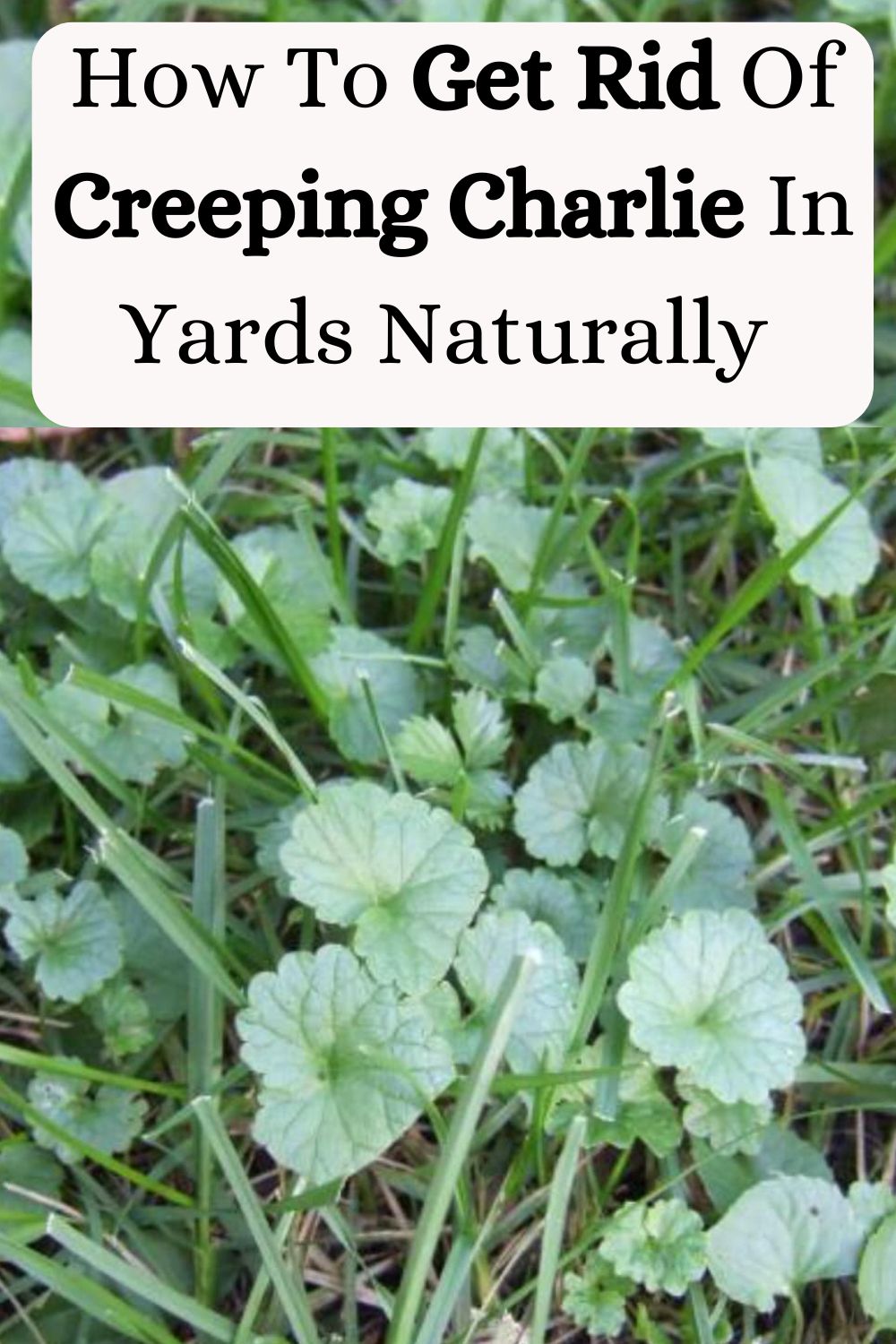The qualities that make creeping Charlie a suitable ground cover plant- resilience, adaptability, low maintenance, and ability to grow a dense mat- make it a nuisance. Give this aggressive plant some room, and it will quickly take over your garden or lawn and even creep into your neighbor’s yard.
Therefore, unless you intensionally planted creeping Charlie, also known as ground ivy, to provide ground cover, it is best to eliminate it as soon as it grows on your lawn or garden before it chokes out your desirable plants.
However, what’s the best way to successfully get rid of creeping charlie plant without harming other plants? Find out below.
What Does Creeping Charlie Look Like?
Creeping Charlie looks a lot like creeping Jenny, so knowing what this weed looks like before you eliminate it from your lawn or garden is essential. So that you don’t confuse creeping Charlie with other plants, here’s how to identify it.
a) Leaves
Creeping Charlie has rounded to kidney-shaped, glossy leaves that are usually 1 to 2 inches in diameter. Regarding the color, these leaves are typically dark green with scalloped or toothed edges and are arranged opposite each other along the stem.
If you crush creeping Charlie leaves, you will be hit by a distinctive minty aroma.
b) Stems
Creeping Charlie has long, creeping, and square stems that can become woody and develop a purplish tint as they mature. This plant spreads horizontally and forms dense mats because it roots at the nodes.
c) Flowers
You can distinguish a creeping Charlie by its flowers. They are small, tubular, purple-blue to bluish-violet with a funnel-like shape. The lower petal is prominent and appears in clusters at the leaf axils in late spring to early summer.
You will find pollinators like bees around the flowers.
d) Growth Habit
If you leave the creeping Charlie unchecked, it will quickly spread and take over large areas of your lawn or garden. This weed grows close to the ground, forming a dense carpet-like mat over the soil.
Related Post: Creeping charlie look alikes
How To Get Rid Of Creeping Charlie In Lawn And Garden
So, you have confirmed that you have a creeping Charlie problem. The next step is to get rid of them before they take over the area and suffocate other plants.
Let’s explore the different effective elimination strategies.
1. Hand Pulling
Top of our list is the most straightforward and affordable method of creeping Charlie removal. This method is effective but labor intensive, so if you choose to go with this approach, ensure you can handle it. You will need to physically pull out the weeds by hand, making sure you take most of the root system, if not all, to prevent regrowth.
Here’s how to get rid of Creeping Charlie through hand pulling:
a) Gather The Tools and Materials
Gloves: Put on gardening gloves to ensure the sticky residue that creeping Charlie leaves behind doesn’t get on your hands.
Knee Pads: If you have a large infestation, it means you will spend much longer on your knees pulling out the weeds, so consider using knee pads to protect your knees while working on the ground.
Hand Trowel or Garden Fork: You’ll need a hand trowel or garden fork to gently loosen the soil around the creeping Charlie patches, making it easier to pull out the roots.
b) Prepare
Put on your gardening gloves and knee pads. Also, put aside a plastic bag or container nearby for collecting the pulled weeds.
c) Identify Creeping Charlie
Identify the areas in your lawn and garden where creeping Charlie is growing. Make sure you do a thorough assessment to ensure you remove all visible patches.
d) Loosen the Soil
Use your hand trowel or garden fork to gently loosen the soil around the creeping Charlie patches. Be careful not to disturb nearby desirable plants.
e) Gently Pull
Grasp the creeping Charlie stems at the base, near the soil, and gently pull them out. If the weed is deeply rooted, use your trowel or fork to lift it from the soil.
f) Dispose
Place the creeping Charlie weeds you pulled out in your plastic bag or container and seal it tightly to prevent the weed from spreading. Dispose of it in your local waste collection, but do not compost it, as it can re-root and continue growing.
g) Repeat as Necessary
You may need to repeat the process several times, especially if you have a severe infestation or miss some patches during your initial removal efforts. Be persistent and closely monitor your lawn and garden for any signs of regrowth.
2. Use Herbicides
If you don’t want to get rid of creeping Charlie in your lawn manually, use selective or non-selective herbicides. Selective herbicides target specific weeds like creeping Charlie without harming desirable plants. On the other hand, non-selective herbicides can kill all plants in the treated area.
Choose a herbicide specifically formulated for broadleaf weeds, which includes creeping Charlie. Ensure the herbicide contains chemicals like 2,4-D, dicamba, or triclopyr because they are effective against this weed.
Also, get a garden sprayer or a handheld spray bottle for herbicide application. You should also wear appropriate protective gear, including gloves, eye protection, long sleeves, and long pants, to minimize exposure to the herbicide.
Steps for Using Herbicides
a) Read the Label
Carefully read and follow the instructions on the herbicide label for information on application rates, timing, safety precautions, and the specific weeds the product is effective against.
b) Time The Application Period Properly
Apply herbicides when creeping Charlie is actively growing, which typically falls in spring or early fall.
c) Weather Conditions
Choose a calm, wind-free day to apply the herbicide. Wind can cause herbicide drift, leading to unintended damage to nearby desirable plants. On the other hand, applying herbicides during rainy or windy conditions will cause run-off.
d) Spot Treatment
Handle small infestations or isolated patches of creeping Charlie by spot-treating the weeds using a handheld spray bottle. Aim the spray directly at the creeping Charlie leaves, carefully avoiding overspray on desirable plants.
e) Broadcast Application
Broadcast application using a garden sprayer is better suited for a larger infestation. Mix the herbicide according to the manufacturer’s instructions and spray it evenly over the affected area, but don’t saturate the soil excessively.
f) Reapplication
You might need to reapply multiple times depending on the infestation severity. Follow the manufacturer’s recommendations for timing between applications. Also, be patient and persistent because it can take time to eradicate creeping Charlie completely.
g) Post-Treatment Care
Skip mowing your lawn for a couple of days to give creeping Charlie enough time to absorb the herbicide. Resume regular lawn maintenance practices, such as mowing, watering, and fertilizing, after a couple of days to encourage the growth of desirable grasses and prevent weed regrowth.
h) Disposal
Rinse the sprayer thoroughly after use, following the herbicide label’s instructions. Dispose of any unused herbicide according to local regulations, and rinse your protective gear as well.
3. Mulching
Suppress the growth of creeping Charlie using a layer of organic or inorganic mulch. Besides helping you deal with weeds, mulching also helps retain soil moisture, regulate soil temperature, and improve overall soil health.
Steps for Mulching
a) Prepare the Area
Remove any existing creeping Charlie and weeds from the area you intend to mulch to prevent weeds from growing through the mulch.
b) Apply the Mulch
Evenly spread some mulch over the soil around your garden plants or in garden beds, aiming for 2-3 inch thickness. I recommend organic mulch like wood chips, straw, leaves, or compost over inorganic ones because, besides suppressing the weeds, it will also improve soil quality as they break down.
c) Maintain the Mulch Layer
Periodically check your mulch to make sure the layer stays at the preferred thickness. If it starts to thin out, replenish it to maintain weed suppression.
d) Mulch Near Plants
Be careful not to pile mulch directly against the stems or trunks of trees and shrubs, as this can create a moist environment that encourages disease.
4. Smothering
This technique works best against small patches of creeping Charlie in garden beds or along walkways. Create a physical barrier over the creeping Charlie-infested area to prevent it from receiving sunlight and growing.
Follow these steps:
- Remove any creeping Charlie and weeds from the area you want to smother.
- Cut the landscape fabric to fit the affected area.
- Lay the fabric over the area you cleared, ensuring it covers the entire infested region.
- Use mulch or weights to secure the fabric edges to the ground. This prevents creeping Charlie from finding openings to grow through.
- Periodically check the smothered area to ensure the fabric stays put. If any creeping Charlie manages to grow around the edges, remove it promptly.
Conclusion
Eliminating creeping Charlie is achievable, but you must be persistent and adopt the right strategies. Also, regardless of your chosen method, being proactive is critical to the successful control of this invasive weed. Remember, keeping this weed out is vital for your lawn’s or garden’s beauty and long-term health.

Hey there, I’m Derek Schew, a writer for Lawnholic.com, where we cover everything and anything related to lawns. As someone who’s spent countless hours tending to my own lawn, I’m passionate about sharing my knowledge and helping others achieve the perfect yard. From lawn care tips to product reviews, I’m committed to providing our readers with the most accurate and up-to-date information available. So whether you’re a seasoned lawn enthusiast or just getting started, I invite you to join our community and discover the joys of a lush, green lawn.


